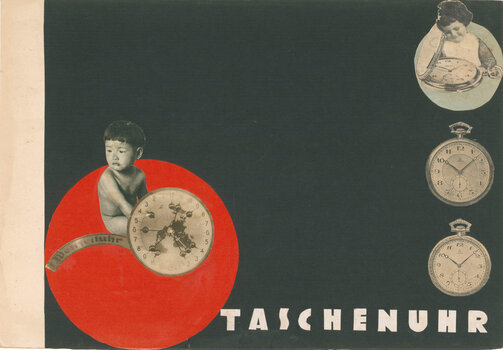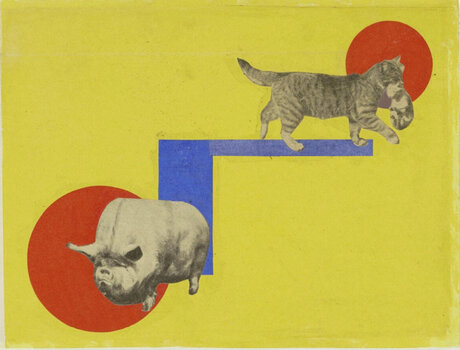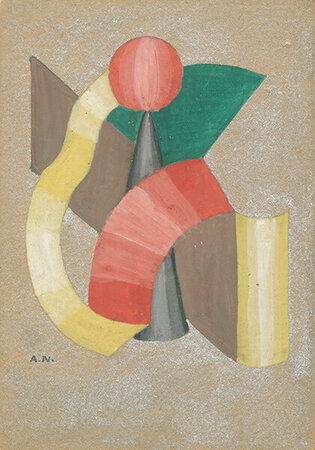
Alice Lex-Nerlinger. Art works
The bequest of painter and photomontage artist Alice Lex-Nerlinger in the Art Collection comprises twelve photomontages and collages, including nine picture book pages from 1928. Some 40 photos and photograms document her experiments with photographic techniques during the 1920s and thematically reflect the artist’s political commitment. The holdings also include about 130 drawings and 40 prints, in particular from the period of “inner emigration” from 1933 and the creative periods after the Second World War.

Alice Lex-Nerlinger was born Alice Erna Hildegard Pfeffer, the daughter of a glass lamp manufacturer, on 29 October 1893 in the district of Kreuzberg in Berlin. She studied at the teaching institution of the Kunstgewerbemuseum (School of Arts and Crafts) in Berlin from 1911 to 1915 under Emil Orlik, among others. Her fellow students included George Grosz, Eva Peter (who later married Grosz), Karl Hubbuch, Hannah Höch and Oskar Nerlinger, whom she married in March 1918 in Strasbourg. In 1919 the couple returned to Berlin, where Alice Nerlinger assumed the artist’s name Lex. In 1924, their son Peter was born. In 1928 Alice Lex-Nerlinger designed nine collaged picture book pages, presumably for him, which formed the foundation for her later political montages. The same year, she and her husband joined both the Communist Party of Germany (KPD) and the Association of Revolutionary Visual Artists of Germany (ASSO). From then on, her artistic work was dedicated to the political struggle. In the period that followed, Lex-Nerlinger created numerous photographs and successfully experimented with photograms. In 1929, she was represented by a number of works at the International Werkbund Exhibition FILM UND FOTO (FiFo) in Stuttgart.
In April 1933, she was excluded from the Reichsverband Bildender Künstler (Reich Association of Visual Artists) and could therefore only work in secret. Lex-Nerlinger destroyed some of her works out of fear of persecution by the National Socialists.
In 1943/1944, she was repeatedly bombed out and, together with her family, was forced to temporarily move in with relatives in the Ostprignitz region. After the war ended, she returned to Berlin-Lichterfelde and taught drawing at Volkshochschule Steglitz adult education centre. In 1948, she worked as a freelancer for the Berliner Zeitung. In 1951, she resettled in East Berlin, where she became a member of the VBK (Association of Visual Artists) in 1952. In 1974, she donated the bequest of her husband Oskar Nerlinger, who had died in 1969, to the Akademie der Künste (East) along with a promised gift of her own works. Alice Lex-Nerlinger died in Berlin on 21 July 1975.
Archive and collection
Early hand drawings such as Komposition II (1920) and Form II (1921); new picture book pages (1928) and other photomontages and collages such as ARBEITEN ARBEITEN ARBEITEN (1928) and Die letzten Jahre vor 1933 / 1931-1933 / Zensur (1933); experimental photos and photograms on the subjects of work and women, including Schneiderpuppe (c. 1928), Näherin (c. 1928) and Der Flieger (1929). Photos as templates for photomontages: Hand mit Uhr and Hände reden 3 (c. 1928); hand drawing Paragraph 218 (1931); post-war works including: Maschinenschlosserlehrlinge Gisela Fehling und Renate Müller im Lehrkombinat „7. Oktober“ (1954); Schaffnerin Anni (1958); hand drawings, prints, photographs, photograms, photomontages, collages.


History of the holdings
In 1974, the bequests of Alice Lex-Nerlinger was transferred to the Akademie der Künste (East) alongside her husband Oskar Nerlinger’s bequest.
In 1971, Alice Lex-Nerlinger had approached Konrad Wolf, President of the German Academy of Arts, to grant posthumous membership to her husband Oskar Nerlinger, who had died in 1969. In return, she offered the Academy her husband’s bequest. Even though Nerlinger was refused membership, Lex-Nerlinger donated his bequest and her living bequest to the Akademie der Künste, which allowed the Nerlinger Archive to be founded in 1974. In 1975, shortly before Alice Lex-Nerlinger passed away, an exhibition by the Akademie der Künste was organised in honour of the two artists.
Since 1994, Alice Lex-Nerlinger and Oskar Nerlinger’s art works have been held in the Art Collection of the Akademie der Künste. The written bequest is kept in the Nerlinger Archive of the Akademie der Künste`s Visual Arts Archive.


